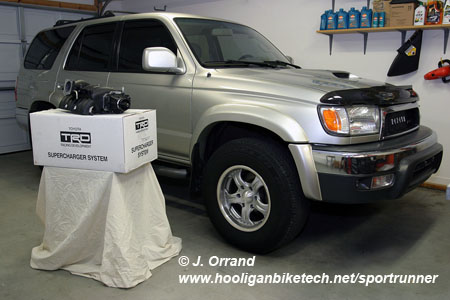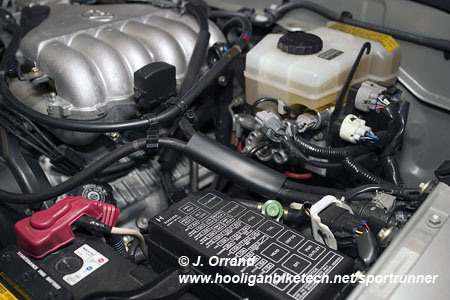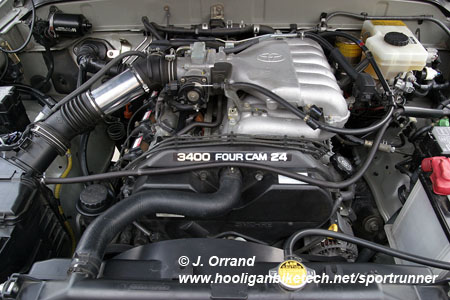There's a lot more to installing a TRD Supercharger on the 3.4L motor than just bolting it on. I kept a blog with notes and information on all the steps I took preparing for the install which is quite detailed.

For this modification you'll need (BARE MINIMUM):
TRD 3.4L Supercharger
*AIC-T
controller to adjust timing (critical to avoid engine damage)
*170 degree thermostat
Rubber O-ring thermostat gasket
*2 step cooler spark plugs (I used Denso Iridium P/N IK22)
Water Wetter
1 Gallon of distilled water
Torque Wrench (very important)
Wide variety of metric sockets and wrenches
Wire type spark plug gap tool
Plastic baggies
Post-it notes
TRD 3.4L Supercharger installation instructions and supplement (some of the
best I've seen)
Marker for marking the drive belts (I used a white paint pen)
10 x 1.25 tap
Copper anti seize compound
Mass air flow sensor cleaner (I used CRC brand Mass Air Flow Sensor Cleaner)
*These items along with a 7th injector and Walbro 190 fuel pump come as a complete set in Underdog Racing's 7th Injector Kit.
Highly
recommended additional components:
Wide band AFR (air fuel ratio) meter (I used an
Innovate LC-1 with DB gauge)
Proper fuel upgrade and closed loop tuning module (I recommend
Underdog Racing's 7th Injector Kit which will also include the necessary
thermostat, spark plugs, and other items)
Toyota FSM (field service manual)
I started by taking several photos of the stock engine configuration for reference. Here are some of the shots showing stock vs. supercharged.
|
|
|
|
|
|
|
|
|
|
|
|

I'm not going to do too much detail on the actual install, as the TRD instructions are quite thorough, however I will note areas where the instructions weren't quite clear for my 2002 model which has the throttle by wire throttle body. You'll also want to start with installing the 170 degree thermostat. Install the spark plugs once the stock manifold has been removed as this makes it much easier to reach them. Also, while the intake air tube is being removed, go ahead and clean the MAF (mass air flow) sensor with specific MAF sensor cleaner. This will insure the ECM has the best possible air flow reading after the SC is installed.
-
On page 9 the note just above step 5 says to use thread lock on the dynamic belt tensioner bolts. When I talked to TRD about this, they said they no longer recommended using thread locking compound, but instead recommended anti seize. That's totally opposite ends of the spectrum, but apparently there were some issues with the dynamic tensioner bolts seizing up over time making future maintenance difficult.
-
There is a one way valve discussed on page 11 step 1 of the TRD installation instructions. My one way valve was not marked as to which way it should be installed. After a quick call to Underdog Racing tech support, I learned you are to install the valve so that air flows from the throttle body to the engine. You can blow on the valve to see which way it flows air. This valve insures a smooth idle.
-
Installation of the throttle body on to the supercharger was different for my 2002 model. I used two of the 8 x 1.25 x 65mm socket head cap screws and 8mm flat washers that came in the TRD supercharger kit on the top of the throttle body. However the other two supplied bolts were too short for the bottom of the throttle body. You'll need to re-use the stock bolts on the bottom for 2002 4Runners with throttle by wire.
-
The vacuum hose routing diagram figure B on page 20 is different for my 2002 model. My 4WD system is electric so there is no VSV valve to contend with and the EVAP canister is simply a bundle of solenoids on the driver's side inner fender. You simply run the hose straight from the EVAP solenoids to the supercharger with no "T" fitting as shown in the diagram.

-
Finally, you'll want to remove the gold bracket from the rear of the stock upper intake manifold and attach it to the same location on the supercharger. This bracket holds the cam cover vent hose in place.
Those were the only caveats I ran into for the install. Total install time took about 4.5 hours which included swapping out the thermostat and spark plugs. You'll want to gap the two step cooler plugs to .032" and if using iridium plugs be sure to use a wire type gapping tool so as not to break the tip of the electrode.

I read the installation instructions over 4-5 times the week before the install. This made the installation go much faster as I nearly had the instructions memorized. I'd check off each step as it was completed to make sure I didn't miss anything. You'll want to separate your bolts into plastic baggies with a Post-it note labeling what each set of bolts is for, such as "upper manifold" or "throttle body". There are quite a few bolts and this insures you get them back in the right spot.
BE SURE to use a torque wrench on all the bolts as a lot of them go into the aluminum head and on studs. Break something here and your install time will go up exponentially and could get expensive. If you don't have a good torque wrench, this is the perfect excuse to go buy one. My only complaint about the TRD instructions is the lack of torque values on the factory bolts, but I guess they could be different for each vehicle. When I was reading through the instructions the final time, I used the Toyota FSM and noted the torque values I'd need next to the corresponding step in the TRD instructions.
For my 2002 4Runner they were:
Thermostat housing bolts - 14
ft/lbs
Alternator pivot bolt - 38 ft/lbs
Alternator pinch nut - 25 ft/lbs
Manifold brace top bolt - 13 ft/lbs
Manifold brace bottom bolt - 30 ft/lbs
Manifold bolts - 13 ft/lbs
Throttle body bolts - 13 ft/lbs
When refilling the radiator I recommend a 60/40 mix of distilled water to antifreeze. Water is more efficient at transferring heat, but you still want enough anti freeze to lubricate and protect the cooling system. The cooling system on my 2002 model holds 9.5 quarts. That converts to roughly 5.7 quarts of water to 3.8 quarts of antifreeze and Water Wetter. This along with the cooler thermostat and two step cooler plugs is supposed to help with the high gear low RPM ping. A 60/40 mix of water to coolant will still protect to around -15* F and 260* boiling.

The ECM is supposed to do some adjusting over the first 500 to 1000 miles as it learns the new air flow parameters. I drove with just the SC installed for a few hundred miles to see how far the stock ECM would adjust. It seemed to adjust some, but I still had quite a bit of high gear/low rpm ping which is terrible on an engine. The supercharger provides a more dense intake charge which is easier to ignite. This can cause the combustion process to occur before the piston is at top dead center putting pressure on the piston and rods at the absolute wrong time. This can cause holes in the pistons, bent rods, or both. As mentioned above I installed the URD AIC-T and tuned the timing which totally solved this problem. I now get ZERO ping lugging Project SportRunner up a hill in OD with the AC on even when the weather is over 100* F.
So far the only place I'm running lean is at WOT (wide open throttle) very close to redline in the RPM range. My 2002 model has an automatic transmission which shifts well before redline and my LC-1 wide band shows an AFR of 11.2 -11.8 during WOT runs. Prior to installing the SC I'd see 10.9 AFRs. In order to get to the lean area of the RPM range, I have to manually shift the transmission into "L" and floor it. Then I'll see 13 or so AFRs close to redline. If you have a manual transmission you'll want to take a close look at this area as you'll be more likely to get into that RPM range than I will. I have installed URD's 7th injector to tune that high RPM range none the less just to be safe. My vehicle has not needed the Walbro 190 upgraded fuel pump as it only needed very small amounts of additional fuel, but you'll want to test yours thoroughly before making that determination for your vehicle. The Walbro 190 is included with the URD 7th Injector Kit regardless, so you'll have it on hand if necessary.
To add MORE power I installed the URD 2.2" Supercharger Pulley and did a thorough tune of the system using URD's 7th Injector Kit.







